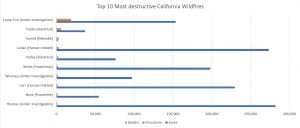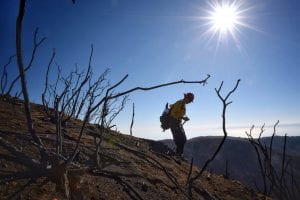As firefighters in California begin to breathe a sigh of relief, they will continue to struggle extinguishing wildfires in years to come. An examination looking into the patterns of the most destructive fires is timely and necessary to find who is accountable for the growing outbreak of fires in the state.
Seven out of the ten most destructive wildfires in California history have occurred within the past four years. This includes the state’s most destructive and deadliest fire to date, the 2018 Camp Fire.
The causes for the most recent fires are still being investigated by the California Department of Forestry and Fire Protection (CalFire). From preliminary reports, a pattern is beginning to develop.
Investigators comb through areas of ignition in close detail looking for anything that could tell the story of how the fire started, how it grew and why.
Of the fires listed in the graph above, six have been found to have been started by electrical failures. Often caused by old equipment igniting overgrown, dry vegetation surrounding power towers. The exceptions being the 2018 Carr Fire, started by tire failure that caused sparks to ignite the dry brush on the side of Highway 299 in Shasta County and the 2015 Valley Fire caused by a faulty residential electric connection.
Of the six largest fires caused by electrical failures, utility giant, Pacific Gas And Electric (PG&E) have been found responsible for the Camp Fire and the 2017 Nuns Fire. An investigation conducted by CalFire found PG&E not responsible for the Tubbs Fire.
A lawsuit has been brought forward against PG&E by victims of the Tubbs Fire. Proceedings have been approved by San Francisco Superior Court Judge Teri Jackson, and are moving forward to conclude if the utility company has partial responsibility in the cause of the fire. The trail is set to start in January 2020 in San Francisco, where PG&E is headquartered.
Initial incident reports carried out by CalFire has found energy provider Southern California Edison (SCE) responsible for the 2018 Woolsey Fire and the 2017 Thomas Fire. Ongoing investigations of the Woolsey Fire conclude that recorded instances of strong winds correspond with a power outage recorded by SCE at the same time and area of ignition.

Fires rage near electrical lines near Montecito, Ca. Santa Ana winds are to blame for the Montecito Complex Fire after winds caused powerlines to touch, which ignited an uncleared fuel bed below. (Photo by Mike Eliason, AP)
Strong winds were also a factor in the ignition of the Thomas Fire. In this case, strong winds caused powerlines owned by SCE to come in contact with each other and created an electrical arch, which then deposited molten material onto an uncleared fuel bed below.
Strong dry winds, known as Santa Ana winds in Southern California and Diablo Winds in Northern California, are a seasonal occurrence in the region lasting from October to March. Making the dry, hot post-summer weather perfect conditions for fire ignition. If the winds occur after an ignition, they fan flames, causing them to spread at alarming rates. While the Santa Ana/Diablo Winds are a common occurrence in the state, recent fires are getting worse and worse.
With this risk factor known to many Californians, the question running through the minds of investigators and victims is ‘what is causing these fires to keep occurring?’ and ‘why are they getting worse?’

CalFire conducting a fires investigation after full containment of the Thomas Fire.
(Photo by Mike Elaison AP)
The answers can be found in the fire investigations conducted by CalFire. Investigators comb through areas of ignition in close detail looking for anything that could tell the story of how the fire started, how it grew and why.
Along with witness accounts that detail the time and area of ignition, items of interest for investigators include: burn patterns caused by downed power lines, blown fuses, and debris from the surrounding ignition area.
This information is then processed and the responsible parties are held accountable. In some cases, it is utility companies, such as PG&E, who are being held financially responsible for the Camp Fire.
PG&E has been found at fault of neglecting to clear dry vegetation from areas surrounding its dangerous, aging equipment. As a result, PG&E has agreed to pay out $11 billion dollars to resolve most insurance claims for the 2017 and 2018 fires it was found responsible for.
The next hurdle is then determining “gross negligence or recklessness” to constitute a fire as a crime.
In other instances, destructive fires are caused by individuals, such as the 2015 Valley Fire. In these instances, fire investigation crews fight against time to get a conviction, if any is applicable. Lake County District Attorney Don Anderson, states the next hurdle is then determining “gross negligence or recklessness” to constitute a fire as a crime.
In the Valley Fire substandard electrical work was found to be the cause of the fire. The homeowner, who is not identified in the media, admitted to doing the work himself and that it was not working properly.
But how is an individual tried? What constitutes “gross negligence or recklessness” in an instance like this? Even if a conviction comes out who is left footing the bill? Can an individual pay the total amount of damages caused by a fire they ignited?
In cases where one individual is found responsible for the fire, the sentence they receive may not reflect the damage caused. As the case with the 1953 Rattlesnake Fire. A trial concluded the fire was a case of arson. The arsonist, Stanford Pattan, pled guilty and only served three years in prison.
With the level of devastation caused by the growing number of wildfires, does being able to hold a person or company responsible bring any sense of relief to the victims?





